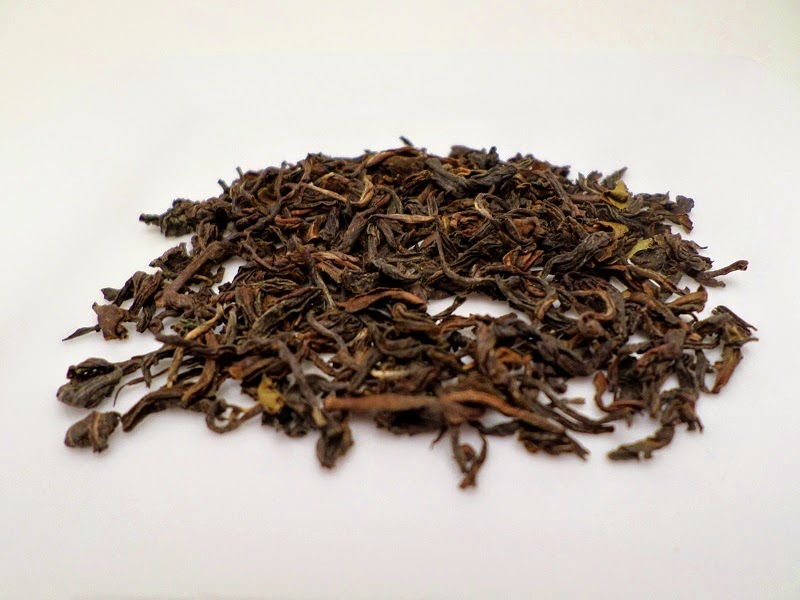 |
| White Peony Sample |
Teavivre Description:
A certified organic, gold medal winning Bai Mudan white tea from Mt. Taimu in Fujian. With an amazingly light and refreshing taste and aroma, TeaVivre's Bai Mudan is a great way to experience high quality Chinese white teas.
Sample provided by
Teavivre
My Review:
I have been wanting to try this tea for a very long time. On a recent order I actually had it in my shopping cart - or so I thought. I kind of grabbed a different one because I wasn't paying attention. So when Angel Chen offered to send it in this summer's white tea and puerh sample round, I got all happy.
 |
| Dry Leaf |
I opened the sample and filled my lungs with a fresh hay and grassy aroma. I decided to prepare this in the gaiwan for a back to back comparison of yesterday's Nepal white tea from What-Cha. I checked Teavivre's website and it recommended 5 g of leaf for a 90 ml gaiwan.
Pouring the leaf into the gaiwan I noticed first that 5 g is a lot of leaf. Second I noticed this sample contains a lot of broken leaf. None of my other samples have been crushed looking and they all came in the same box. Looking at the product page on Teavivre's website suggests my sample got smushed before shipping.
If you click on the picture it expands and you can better see the large amount of white down on the buds. Broken leaf aside, this is a good looking leaf.
 |
| Steeping Leaf |
My instinct was to use only half the leaf because I prefer a light subtle cup, but I opted to continue with Teavivre's instruction.
I heated the water to 195 F (90 C) and steeped in the gaiwan for 25 seconds. The leaf filled the gaiwan.
The aroma is strong and leaves me totally unable to explain what it resembles. Certainly not the hay, grass, melon, notes I normally think. This is a heavier vegetable scent and umami or meat like.
 |
| Darker Than Expected |
I poured the liquor into a tiny china cup revealing a dark yellow, almost orange brew. I waited for it to cool for a few moments. The first sip is bitter. Maybe I should have used 10 seconds, a lower temperature, or half the leaf. I don't know. I do know I did not enjoy this cup. The bitterness was puckeringly so. The taste lacked the depth I expected. This comes off as mostly wood pulp tasting as prepared.
I have never given Teavivre a negative review before. I am willing to believe once I work with the parameters I will find this much improved.
Finishing the cup, and I admit I almost didn't, I poured the leaf on my exam plate. Man, that is a lot of leaf. Many people prefer it this way. I am not one of them.
 |
| A Lot More Leaf Than It Appears |
The leaf is full and fresh but it definitely looks chopped or crushed with very few intact leaves. That is also a first for my experience with Teavivre. I have always been extremely impressed with their tea.
For the next steep I decided to make a change. The gaiwan went back on the shelf and out came my trusty glass French press.
I also chose to lower the water temperature down to 180 F and used more of it (10 oz).
Second steep was 25 seconds.
I poured the bright yellow liquor into a mug and let it cool.
 |
| In The Mug |
This is much improved. The bitterness is gone. The flavor is much more gentle. What I get now is a really nice grassy fresh alfalfa hay. It has a very mild apricot taste note mixed in with the hay. The aftertaste is nicely lingering.
I guess my problem is I expected more out of this one. When the parameters get adjusted to suit me, it is pleasant enough. It just doesn't have the depth I want from white tea.
I have enough to try this again. Next time I'll do it my way - half the sample and lower temperature. If I change my opinion, I'll come back and update this post.
Sorry Teavivre, but for the first time I am not overly impressed. While your Silver Needle remains one of my favorites, this white peony is just OK. It is probably because I am still flinching from the first steep.
Visit the Teavivre website
here.
--------------------
Update!
The day after originally posting this review I decided I would try again. This time I did it my way. I used half the sample packet (2.5g) and 10 oz of water heated to 180F. The steep was 1 minute. The difference is day and night. The liquor is clear, bright, and yellow. It has the wonderful alfalfa hay aroma. The sip reminds me of the dehydrated camellia flowers I have previously tried from Teavivre. I liked them because they were different. The taste is slightly dry and though it still makes me think wood pulp, it is a very pleasant experience today. I still get cucumber/melon notes. The aftertaste lingers and grows sweeter. My only negative comment with this session today is the leaf from this second sample packet also looks like mulch. It probably does not negatively impact the flavor but it does impact the aesthetics of the tea. Watching the leaf is important to me and I love to look at beautiful full leaf. This one lacks that aspect. Otherwise I did very much enjoy today's cup.




















































